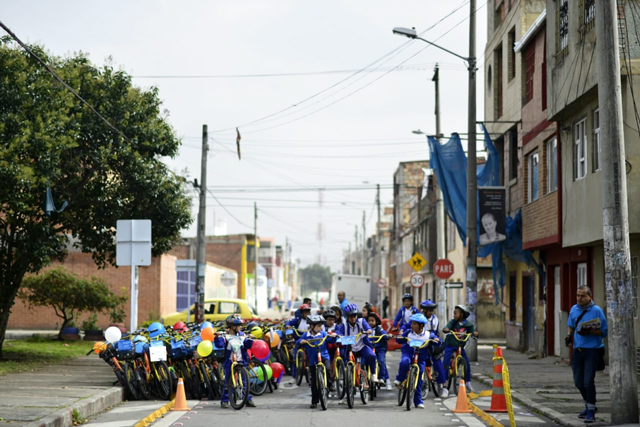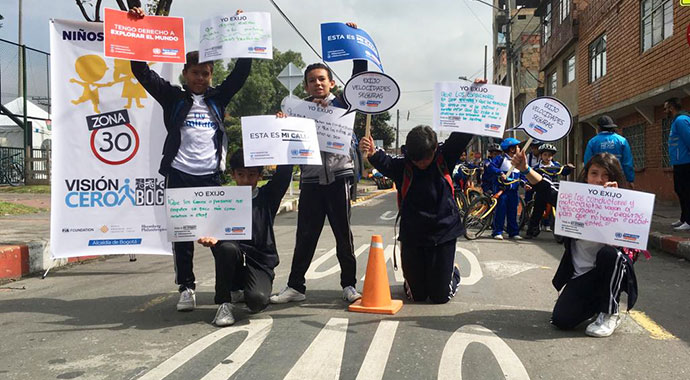
An organized bike to school day during Global Road Safety Week in Bogotá. Photo by Bogotá Secretariat of Mobility
This week, the United Nations celebrates the fifth iteration of its Global Road Safety Week with the theme of leadership. The topic highlights the role that elected leaders have in enforcing and implementing road safety goals at the national and local levels.
Road crashes are the leading cause of death for young people in the world (ages 5 to 29), according to the latest report from the World Health Organization, and the problem is getting worse, not better. This public health crisis disproportionately affects pedestrians, cyclists and motorcyclists living in developing countries.
Some cities are stepping up to the challenge, though, by defining road safety as a priority and making policy changes to create safer roads for all users.
In Bogotá, Colombia, the District Department of Mobility made road safety a focal point after seeing between 500 and 600 lives lost on the city’s roads every year. The city has been working with WRI and the Bloomberg Initiative for Global Road Safety to lower the number of road crash victims.
In 2017, the city adopted a “safe system” approach as part of the development of a comprehensive road safety plan. Speed limits around the city were reconsidered according to the function and context of roads, and new infrastructure and enforcement measures were added.
The speed limit for five of the most critical roads in the city, which registered around 150 road crash deaths per year, was lowered from 60 kilometers per hour to 50. The new speed limit, implemented in October 2018 and enforced with the help of traffic police, has reduced the number of fatalities by 40%, resulting in 32 lives saved, according to the District Secretariat of Mobility. The Secretariat of Mobility has also identified low-speed zones, where speed limits will be reduced to 30 kilometers per hour, in order to protect and prioritize children and others who move by foot or bicycle.

Low speed zones are helping to make school areas safer. Photo by WRI
From October 2018 to March 2019, road crash fatalities decreased 37%, according to Juan Pablo Bocarejo, Secretary of Mobility of Bogotá. We recently spoke with Bocarejo about the importance of political leadership in road safety and what he has learned from Bogotá’s experience.
Why is leadership important in road safety and for the implementation of a safe system approach?
Juan Pablo Bocarejo: Leadership is fundamental to structure policies and guidelines that will last over time. The World Health Organization states that institutional management is one of the main foundations for ensuring the implementation and sustainability of road safety strategies. With leaders committed to road safety and the technical capacity required within our institutions, we can consolidate medium- and long-term plans and generate a greater impact on society.
What has been your most important achievement and what difficulties have you faced in the process?
Bocarejo: Our most important achievement has been to position road safety as a priority within the public agenda. Starting a road safety discussion with the community and city officials, in the areas of transportation, mobility and planning, is essential for the issue to have the relevance it requires. However, getting to this point has not been an easy task. We have worked intensively to generate a new language and understanding of road safety with professionals who are used to approaching mobility with a focus on vehicles and not on people.
What are your recommendations for other leaders who want to protect lives on the road?
Bocarejo: Relying on data is fundamental to propose informed solutions, follow up on structured strategies and show results. Another recommendation is to focus all road safety efforts on one large goal: saving lives. When we are talking about a problem that is ending the lives of our citizens, we can work on a mobility system that ensures the safety of all road users.
What are the lessons you take from your work in road safety, and what would you do differently?
Bocarejo: We understood that communication is an essential element for work in road safety. Reporting what we are doing and why we are doing it has helped us make this issue a priority within and outside the institution. A large part of our work in this area has been focused on generating training for stakeholders in the mobility system. With journalists, for instance, we have had several workshops in which we give them the tools they need to cover the issue. Their support has been very important for us to mitigate this public health problem. We have also recognized that it is vital to have allies that support the work and decisions made by the government. We have been fortunate to work hand in hand with leaders in the field, such as WRI, who have supported our administration in the city from the start.
How can we have more road safety leaders in the community?
Bocarejo: Making the most of communication channels and training spaces to inform citizens. Sharing the knowledge generated within the institution and by authorities helps us make road users road safety champions. By generating spaces for interaction with communities through civil society organizations, advocacy groups and social networks, we can count on more people recognizing road crashes as a public health problem and becoming road safety leaders.
A version of this blog was originally published on WRI México.
Natalia Lleras is a Project Manager for Mobility and Road Safety at WRI Ross Center for Sustainable Cities.
Veronica Linares is a Communications Associate at WRI Ross Center for Sustainable Cities.








